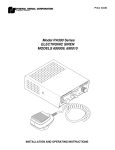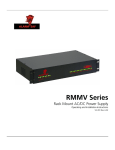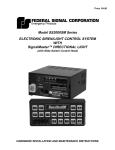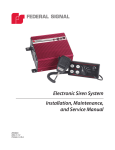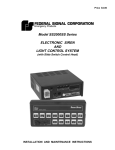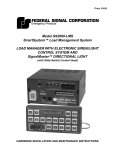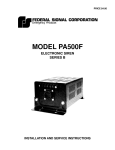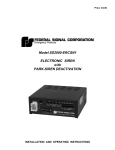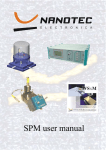Download AVTronics PPA-300 Operating instructions
Transcript
Price $4.00 Model PA300 Series ELECTRONIC SIREN MODELS 690000, 690001, 690002, 690004 INSTALLATION AND OPERATING INSTRUCTIONS LIMITED WARRANTY The Signal Division, Federal Signal Corporation (Federal), warrants each new product to be free from defects in material and workmanship, under normal use and service, for a period of two years on parts replacement and one year on labor from the date of delivery to the first user-purchaser. During this warranty period, the obligation of Federal is limited to repairing or replacing, as Federal may elect, any part or parts of such product which after examination by Federal discloses to be defective in material and/or workmanship. Federal will provide warranty for any unit which is delivered, transported prepaid, to the Federal factory or designated authorized warranty service center for examination and such examination reveals a defect in material and/or workmanship. This warranty does not cover travel expenses, the cost of specialized equipment for gaining access to the product, or labor charges for removal and re-installation of the product. Lamps, flash tubes, or batteries are not covered under warranty. This warranty does not extend to any unit which has been subjected to abuse, misuse, improper installation or which has been inadequately maintained, nor to units which have problems relating to service or modification at any facility other than the Federal factory or authorized warranty service centers. THERE ARE NO OTHER WARRANTIES, EXPRESSED OR IMPLIED, INCLUDING BUT NOT LIMITED TO, ANY IMPLIED WARRANTIES OF MERCHANTABILITY OR FITNESS FOR A PARTICULAR PURPOSE. IN NO EVENT SHALL FEDERAL BE LIABLE FOR ANY LOSS OF PROFITS OR ANY INDIRECT OR CONSEQUENTIAL DAMAGES ARISING OUT OF ANY SUCH DEFECT IN MATERIAL OR WORKMANSHIP. SECTION I GENERAL DESCRIPTION The Model PA300 Series can drive one 11-ohm impedance, high power (100W) or low power (58W) speaker. The Tap II feature allows the driver to change the siren sound from wail to yelp (or vice-versa) via the vehicle’s horn ring. Tap II provides especially effective traffic clearing capability. In addition to Tap II, additional alternate sounds can be activated in two other selector switch positions by depressing and holding the horn ring for as long as the alternate sound is desired. The charts in Section IV of this manual illustrate the operation of these features more fully. Other special features of the Model PA300 Series include: 290A4452-01 Figure 1-1. Model PA300 Series Electronic Siren. The Federal Model PA300 Series (figure 1-1) is a precision built, efficient and economical, full-featured electronic siren of advanced design. It provides wail, yelp, hi-lo (Models 690000 and 690001) or priority (Models 690002 and 690004) siren tones, as well as the Tap II feature, public address (PA), radio rebroadcast and an air horn sound. The siren should be installed in negative ground vehicles with 12-volt electrical systems. It is protected against failure modes (including reversed polarity) by a fuse that is replaceable without tools. No components protrude from the bottom of the siren to interfere with mounting arrangements. • High degree of reliability is achieved through the use of integrated circuits and silicon output transistors. • Control panel is illuminated with LED's. • Newly designed printed circuit board provides improved performance and durability under a wide range of environmental conditions. PA300 Series Models: A noise-cancelling microphone is wired-in (Models 690000 and 690002) to prevent loss or theft. It provides high quality voice reproduction without feedback “squeal”. The microphone push-to-talk switch overrides any siren signal for instant PA use. PA and radio volume are adjustable by means of a front panel GAIN control. Radio inter-connect wires are built-in. No additional cables are required. Models 690001 and 690004 are supplied with a microphone jack. To use the PA functions, order the optional Model MNCT-SB microphone. -1- • 690000 12V, 100W, HI-LO with microphone • 690001 12V, 100W, HI-LO with microphone jack • 690002 12V, 100W, PRIORITY with microphone • 690004 12V, 100W, PRIORITY with microphone jack SECTION II SPECIFICATIONS Input Voltage ............................................................... 11VDC to 15VDC. Polarity ......................................................................... Negative ground only. Standby Current (MANUAL) ...................................... 60ma (typical). Operating Temperature Range ................................... -30°C to +65°C. Operating Current (Wail mode) .................................. 10 amperes, max. (@ 13.6VDC) (11 ohm load, @ high power) Frequency Range (typical) .......................................... 725 to 1800Hz. Cycle Rate (typical) ...................................................... Wail- 15 cycles/min. Yelp- 220 cycles/min. Hi-Lo- 70 cycles/min. (690000 and 690001) Priority 1300 cycles/min. (690002 and 690004) Voltage Output (approx.) ............................................. 64V peak-to-peak. Dimensions (HWD) ...................................................... 2-1/2" (6.35cm) x 6-1/2" (16.51cm) x 8-1/2" (21.59cm). Net Weight (incl. microphone) .................................... 4-1/2 lbs. (2.04kg). Shipping Weight .......................................................... 6-1/2 lbs. (2.94kg). NOTE The following parameters were obtained with the radio input potentiometer and GAIN control set at maximum. Audio Frequency Range .............................................. 300 to 10,000Hz. Harmonic Audio Distortion (300-3,000Hz) ................. 10% max. all power levels from 1/2 to 50 watts (frequency response ±3dB). Input Impedance (Radio) ............................................. 2000 ohms. Input voltage required to obtain 20VRMS across speaker load (Radio) .................................................. 0.30VRMS. -2- SECTION III INSTALLATION SAFETY MESSAGE TO INSTALLERS OF ELECTRONIC SIRENS • Sound output will be severely reduced if any objects are in front of the speaker. If maximum sound output is required for your application, you should ensure that the front of the speaker is clear of any obstructions. • Install the speaker(s) as far forward on the vehicle as possible, in a location which provides maximum signaling effectiveness and minimizes the sound reaching the vehicle’s occupants. Refer to the National Institute of Justice guide 500-00 for further information. Qualifications • To properly install an electronic siren: you must have a good understanding of automotive electrical procedures and systems, along with proficiency in the installation and service of safety warning equipment. Always refer to the vehicle’s service manuals when performing equipment installations on a vehicle. Mounting the speakers behind the grille will reduce the sound output and warning effectiveness of the siren system. Before mounting speakers behind the grille, make sure the vehicle operators are trained and understand that this type of installation is less effective for warning others. • Sound propagation and warning effectiveness will be severely reduced if the speaker is not facing forward. Carefully follow the installation instructions and always install the speaker with the projector facing forward. • DO NOT install the speaker(s ) or route the speaker wires where they may interfere with the operation of air bag sensors. • Installation of two speakers requires wiring speakers in phase. • Never attempt to install aftermarket equipment, which connects to the vehicle wiring, without reviewing a vehicle wiring diagram - available from the vehicle manufacturer. Insure that your installation will not affect vehicle operation and safety functions or circuits. Always check vehicle for proper operation after installation. • DO NOT install equipment or route wiring or cord in the deployment path of an air bag. • Locate the control head so the vehicle, controls, and microphone can be operated safely. • When drilling into a vehicle structure, be sure that both sides of the surface are clear of anything that could be damaged. WARNING The lives of people depend on your proper installation and servicing of Federal products. It is important to read and follow all instructions shipped with the products. In addition, listed below are some other important safety instructions and precautions you should follow: Before Installation • Sound Hazards • Your hearing and the hearing of others, in or close to your emergency vehicle, could be damaged by loud sounds. This can occur from short exposures to very loud sounds, or from longer exposures to moderately loud sounds. For hearing conservation guidance, refer to federal, state, or local recommendations. OSHA Standard 1910.95 offers guidance on “Permissible Noise Exposure.” • All effective sirens and horns produce loud sounds (120 dB) that may cause permanent hearing loss. Always minimize your exposure to siren sound and wear hearing protection. Do not sound the siren indoors or in enclosed areas where you and others will be exposed to the sound. • Federal Signal siren amplifiers and speakers are designed to work together as a system. Combining a siren and speaker from different manufacturers may reduce the warning effectiveness of the siren system and may damage the components. You should verify or test your combination to make sure the system works together properly and meets federal, state and local standards or guidelines. During Installation • • DO NOT get metal shavings inside the product. Metal shavings in the product can cause the system to fail. If drilling must be done near the unit, place an ESD approved cover over the unit to prevent metal shavings from entering the unit. Inspect the unit after mounting to be sure there are no shavings present in or near the unit. After Installation DO NOT connect this system to the vehicle battery until ALL other electrical connections are made, mounting of all components is complete, and you have verified that no shorts exist. If wiring is shorted to vehicle frame, high current conductors can cause hazardous sparks resulting in electrical fires or flying molten metal. • Be sure the siren amplifier and speaker(s) in your installation have compatible wattage ratings. • In order for the electronic siren to function properly, the ground connection must be made to the NEGATIVE battery terminal. • After installation, test the siren system and light system to ensure that it is operating properly. • Test all vehicle functions, including horn operation, vehicle safety functions and vehicle light systems, to ensure proper operation. Ensure that installation has not affected vehicle operation or changed any vehicle safety function or circuit. • After testing is complete, provide a copy of these instructions to the instructional staff and all operating personnel. • File these instructions in a safe place and refer to them when maintaining and/or reinstalling the product. Failure to follow all safety precautions and instructions may result in property damage, serious injury, or death to you or others. -3- MOUNTING UNDER DASH CAUTION 1/4" SPLIT LOCKWASHER 1/4-20 HEX NUT CAUTION Damage to unit will occur if not properly fused. Ensure that an in-line fuse (20A) and fuseholder are installed in the red power cable lead. 1/4-20 x 3/4" HEX HD CAP SCREW 1/4-20 x 1/2" HEX HD. CAP SCREW WITH LOCKWASHER MUST BE USED AS SHOWN LONGER SCREW WILL CAUSE CIRCUITRY DAMAGE. 3-1. UNPACKING. MOUNTING BRACKET 1/4-20 x 1/2" HEX HD. CAP SCREW After unpacking the Model PA300 Series, examine it for damage that may have occurred in transit. If the equipment has been damaged, file a claim immediately with the carrier stating the extent of damage. Carefully check all envelopes shipping labels and tags before removing or destroying them. 1/4" SPLIT LOCKWASHER Before proceeding with installation, ensure that the following parts have been included in the carton. 1/4-20 x 1/2" HEX HD. CAP SCREW KIT CONTENTS LIST Qty. Description 1/4" SPLIT LOCKWASHER Part No. MICROPHONE CABLE NOTE: ONLY ONE BRACKET IS SUPPLIED 290A4452-02 Figure 3-1. Installation of PA300 Under Dash. 1 2 2 1 1 Cable Assembly Lockwasher, 1/4 Screw, 1/4-20 x 1/2 Mtg. Bracket Label, Warning 1461360 7074A015 7002A008-08 85361059 1612339 To install the unit under the dash, determine the mounting location and proceed as follows (see figure 3-1). CAUTION The unit must be installed in an adequately ventilated area. Never install near heater ducts. 3-2. MOUNTING BRACKET. WARNING A. Use the mounting bracket as a template and scribe two drill positioning marks at the selected mounting location under the dash. When installing equipment inside air bag equipped vehicles, the installer MUST ensure that the equipment is installed ONLY in areas recommended by the vehicle manufacturer. CAUTION Before drilling holes in ANY part of a vehicle, be sure that both sides of the mounting surface are clear of parts that could be damaged; such as brake lines, electrical wiring or other vital parts. Failure to observe this warning will reduce the effectiveness of the air bag, damage the air bag, or potentially damage or dislodge the equipment, causing serious injury or death to you or others. B. Drill two 1/4-inch diameter holes at the position marks. The electronic siren comes equipped with a swinging bracket which enables it to be mounted in variety of positions. Positioning the bracket above the unit allows mounting to the underside of the dash. Positioning the bracket below the unit will permit mounting on any horizontal surface. C. Secure the mounting bracket to the dash with user-supplied 1/4-20 x 3/4 hex head screws, 1/4 split lockwashers and 1/4-20 hex nuts as shown in figure 3-1. D. Secure the electronic siren to the mounting bracket with 1/4-20 x 1/2 hex head screws and 1/4 split lockwashers as shown in figure 3-1. The unit should be mounted in a position that is both comfortable and convenient to the operator. Keep visibility and accessibility of controls in mind. -4- CAUTION To avoid damage to the unit, the 1/4-20 x 1/2 hex head cap screws and the 1/4 split lockwashers must be used as shown in figure 3-1. 4 E. Tilt the unit to the desired position. Tighten the 1/4-20 x 1/2 hex head screws. 2 3-3. POWER CABLE INSTALLATION. BLU (SPKR, COM) 8 BRN (SPKR, HI) 9 ORG (SPKR, LO) 5 WHT (HORN) WHT/YEL (HORN RING) ZIP CORD 1 7 6 7 8 9 10 1 2 3 4 5 BRN (RIBBED) (RADIO) BRN (NON-RIBBED) (RADIO) RED (POWER +) CAUTION BLK (GROUND -) 290A4452-04C Wiring changes have been made which utilizes a new type of power cable. If this unit is used to replace an older PA300, use the optional cable adaptor (761300) to connect the originally installed power cable to the new siren. Figure 3-3. Control Cable Wiring Diagram. 100W speaker to SPEAKER HIGH POWER) as shown in the Control Cable Wiring Diagram, figure 3-3. Connect the other speaker wire to the blue (SPKR, COM) wire. This unit is NOT designed as a replacement in a two-speaker installation. The siren amplifier WILL be damaged if two speakers are installed. A. B. Radio. To allow incoming radio messages to be rebroadcast over the outside speakers, connect the two brown zip cord leads (pins 1 and 2) across the two-way radio’s speaker. Speaker. The unit is designed to operate with one 11ohm impedance speaker or one low power (58W) speaker. See figure 3-2. C. Horn Ring. In order to utilize the Tap II and Press-andHold features of the siren, the following procedure must be performed. CAUTION Damage to the unit will occur if speaker wires are improperly connected. NEVER CONNECT the brown SPEAKER HIGH POWER (100W) wire and orange SPEAKER LOW POWER (58W) wire together to the speaker(s). 1. Locate the wire that connects the vehicle horn ring switch to the horn or horn relay. Cut this wire. 2. See figure 3-4. Splice the white/yellow control cable wire (pin 4) to the horn ring side of the wire that was cut in step 1. Insulate the splice with user-supplied wire nuts. Using 18 gauge wire, connect one speaker lead (58W speaker to SPEAKER LOW POWER or CAUTION The horn ring transfer circuit of the siren is capable of switching a maximum of 2-amperes. Some vehicles do not have a horn relay and, consequently, will draw more than 2amperes when the vehicle horn is activated. Consult your vehicle service manual or a qualified mechanic to determine the current required to activate the horn. If it is less than 2-amperes, perform the procedure in step 3. If it is greater than 2-amperes, perform steps 4 through 10. 290A4452-03 Figure 3-2. Rear View of PA300. -5- VEHICLE HORNS Power for the siren can be obtained from the vehicle’s power distribution center or directly from the vehicle battery. If power is going to be obtained directly from the vehicle battery, drill a hole in the vehicle firewall for the power lead to enter the engine compartment. Place a grommet or similar device in the hole to protect the wire against damage from rough edges. STEERING COLUMN RELAY (USER SUPPLIED) SW TO BATTERY CUT WIRE WHT TO HORN, OR HORN RELAY CONTROL CABLE ASSEMBLY WHT/YEL TO HORN SWITCH 290A4452-05 CAUTION Figure 3-4. Horn Ring Connections. Before drilling holes in ANY part of the vehicle, ensure that both sides of the surface are clear of parts that could be damaged; such as brake lines, fuel lines, electrical wiring or other vital parts. 3. Splice the white control cable wire (pin 5) to the horn side of the cut wire. Insulate the splice with a user-supplied wire nut. 4. Obtain a SPST relay of sufficient contact current capacity to activate the vehicle horn. Refer to figure 3-4 while performing the following steps. 5. If your vehicle has a negative ground electrical system, perform the procedure as follows: NOTE Mount the relay in a suitable location. This unit is NOT designed to operate with positive ground. 6. Connect the horn side of the wire cut in step 1 to the relay contact terminal. 1. Route the red power (+) and the black power (-) control cable leads, through the previously drilled hole, into the engine compartment. Route the wires through existing clamps and holders toward the battery. 7. Determine the “sense” of the vehicle’s horn ring activation circuit, i.e., does the horn circuit require a switched positive voltage or switched ground for activation. 8. Connect the relay wiper terminal to the positive or negative potential determined in step 7. 2. To protect the red wire when connected to the battery terminal, use an in-line fuseholder and 20-ampere fuse (not supplied). The fuseholder should be installed as close as practical to the battery. If necessary, additional #14 gauge or heavier wire can be spliced to the red lead. 9. Connect the white control cable wire to one end of the relay coil. 10. Connect the other end of the relay coil to the opposite potential of that connected to the wiper in step 8. D. WARNING If wires are shorted to the vehicle frame or each other, high current conductors can cause hazardous sparks resulting in electrical fires and molten metal. Connection to Power Source. CAUTION Verify that no short circuits exist before connecting to the Positive (+) battery terminal. Damage to the unit will occur if not properly fused. Ensure that an in-line fuse (20A) and fuseholder are installed in the red (+) power cable lead. DO NOT connect this system to the vehicle battery until ALL other electrical connections are made and mounting of all components is complete. The PA300 Series can operate only from a 12-volt negative ground vehicle electrical system. Therefore, before making any electrical connections, determine the polarity of the vehicle electrical system ground. Failure to observe this WARNING will result in fire, burns and blindness. -6- 1. Connect the in-line fuseholder lead to the positive (+) battery terminal. D27 C20 R11 C8 IC7 R21 C29 R51 IC3 IC1 + 2. Connect the black wire to the negative terminal of the battery. C49 AIR HORN J9 C7 IC5 + J9 R20 R15 R22 3-4. AIR HORN PRESS-AND-HOLD MODIFICATION. PEAK PEAK AIR HORN J8 IC6 D25 R16 PEAK The unit comes from the factory set so that the peak-and-hold sound will be heard when the Selector switch is set to MANUAL and the vehicle horn ring is activated. To change the sound to air horn, merely move jumpers J8 and J9 from the “PEAK” position on the P.C. board to the “AIR” position (see figure 3-5). J8 R23 C48 D21 + R26 AIR HORN PEAK R31 D26 + C9 AIR HORN C46 IC10 290A4452-06 Factory Configuration 3-5. RELATIVE PA LOUDNESS ADJUSTMENT. D27 C20 R11 C8 IC7 After the electronic siren is completely installed in the vehicle, set the Selector switch to MANUAL. Depress the microphone push-to-talk switch, speak in a normal voice, and adjust the GAIN control for the desired sound level outside the vehicle. Turn-on the vehicle’s two-way radio and adjust the volume to a comfortable listening level inside the vehicle. Then set the Selector switch to RADIO. Stand outside of the vehicle and note the radio rebroadcast loudness. If the sound volume is too loud or too soft, using a small flat blade screwdriver, adjust R39 from the back of the siren (see figure 3-6) to the desired sound level. R21 C29 R51 IC3 IC1 + C49 AIR HORN J9 C7 IC5 + J9 R20 R15 R22 PEAK PEAK AIR HORN J8 IC6 D25 R16 PEAK J8 R23 C48 D21 + R26 AIR HORN PEAK R31 D26 + C9 AIR HORN IC10 C46 290A4452-07 Air Horn Configuration After the adjustment is completed, the loudness of the radio rebroadcast and public address may be varied with the front panel GAIN control. Figure 3-5. Press and Hold Modification. 3-6. TESTING AFTER INSTALLATION. WARNING All effective sirens and horns produce loud sounds (120 dB) that may cause permanent hearing loss. Always minimize your exposure to siren sound and wear hearing protection. Do not sound the siren indoors or in enclosed areas where you and others will be exposed to the sound. R39 After installation; test the electronic siren, including horn operation, to ensure that it is operating properly. 290A4452-08 After testing is complete, provide a copy of this manual to all operating personnel. Figure 3-6. Relative PA Loudness Adjustment. -7- SECTION IV OPERATION SAFETY MESSAGE TO OPERATORS OF FEDERAL SIGNAL ELECTRONIC SIRENS AND LIGHT/SOUND SYSTEMS • WARNING The lives of people depend on your safe operation of Federal products. It is important to read and follow all instructions shipped with the products. In addition, listed below are some other important safety instructions and precautions you should follow: Signaling Limitations • Be aware that the use of your visual and audible signaling devices does not give you the right to force your way through traffic. Your emergency lights, siren, and actions are REQUESTING the right-of-way. • Although your warning system is operating properly, it may not alert everyone. People may not hear, see, or heed your warning signal. You must recognize this fact and continue driving cautiously. • Situations may occur which obstruct your warning signal when natural or man-made objects are between your vehicle and others. This can also occur when you raise your hood or trunk lid. If these situations occur, be especially careful. Qualifications • To properly use an electronic siren and speaker(s): you must have a good understanding of general vehicle operation, a high proficiency in the use of safety warning equipment, and thorough knowledge of state and federal UNIFORM TRAFFIC CODES. Sound Hazards • • Your hearing and the hearing of others, in or close to your emergency vehicle, could be damaged by loud sounds. This can occur from short exposures to very loud sounds, or from longer exposures to moderately loud sounds. For hearing conservation guidance, refer to federal, state, or local recommendations. OSHA Standard 1910.95 offers guidance on “Permissible Noise Exposure.” Driving Limitations All effective sirens and horns produce loud sounds (120 dB) that may cause permanent hearing loss. Always minimize your exposure to siren sound, roll up your windows and wear hearing protection. Do not sound the siren indoors or in enclosed areas where you and others will be exposed to the sound. Only use the siren for emergency response situations. Sound Limitations • • Frequently inspect the speaker to ensure that it is clear of any obstruction, such as mud or snow, which will reduce maximum sound output. Before using the vehicle, check to see if the siren speakers are concealed from view. If the siren speaker is not in clear view on the front of the vehicle, use extra caution when operating the vehicle. A concealed siren speaker installation is less effective at warning others. • At the start of your shift, you should ensure that the light/sound system is securely attached to the vehicle and operating properly. • If the unique combination of emergency vehicle equipment installed in your vehicle has resulted in the siren controls being installed in a position that does not allow you to operate them by touch only, OPERATE CONTROLS ONLY WHILE YOUR VEHICLE IS STOPPED. • If driving conditions require your full attention, you should avoid operating the siren controls while the vehicle is in motion. Continuing Education • Maximum sound output will be severely reduced if any objects are in front of the speaker. If your installation has obstructions in front of the speaker, drive even more cautiously. File these instructions in a safe place and refer to them periodically. Give a copy of these instructions to new recruits and trainees. Failure to follow these safety precautions may result in property damage, serious injury, or death to you, to passengers, or to others. -8- A. 4-1. GENERAL. All controls utilized during normal operation of the Model PA300 are located on the front panel (see figure 4-1). RADIO. In this position, incoming radio messages are amplified by the siren and rebroadcast over the outside speaker. The wired-in noise cancelling microphone provides high quality voice reproduction in the public address mode. The microphone push-to-talk switch will override all siren functions, except radio rebroadcast, for instant PA use. B. MANUAL. In this position, it is possible to operate the siren by activating the HORN/SIREN switch. The siren can also be activated by means of an auxiliary switch, such as the horn ring button (refer to paragraph 4-6). 4-2. GAIN CONTROL. The GAIN control is used to turn the siren on and off. Also, it is used to control the volume when the siren is used for public address or radio amplification. Clockwise rotation of the knob increases voice volume in the public address or radio amplification mode. The GAIN control does not control the volume of the siren signals. C. WAIL. In this position, the siren produces a continuous “wailing” sound, up and down in frequency. D. The maximum clockwise setting of the control will be determined, in most cases by the point at which feedback or “squeal” occurs. This will depend upon the microphone gain, open windows, speaker placement, proximity of reflecting surfaces (building or other vehicles), etc. Adjust the GAIN control to a position just below the point at which feedback occurs or as desired. YELP. In this position; a continuous, rapid “warbled” tone is generated. E. HI-LO (Models 690000 and 690001). In this position, a two-tone sound will be heard. This distinctive tone may be reserved for any special indication or situation. 4-3. SELECTOR SWITCH. The Selector switch is a five-position rotary switch used to select the mode of operation. The following are positions on the Selector switch. F. PRIORITY (Models 690002 and 690004). In this position, a rapid "YELP" sound will be heard. This distinctive tone may be reserved for any special indication or situation. 4-4. HORN/SIREN SWITCH. The HORN/SIREN switch, located on the left side of the front panel, activates the electronic air horn sound (up) or peak-and-hold sound (down) in any siren mode except radio. 290A4452-09 Figure 4-1. Front View. -9- PRESS AND HOLD FUNCTIONS (Models 690000 and 690001) 4-5. TAP II FUNCTIONS. Tap II allows the driver to change the siren sound via the vehicle’s horn ring. This feature is especially effective for clearing traffic. The chart below demonstrates how the horn ring can be used to change the siren sound: Selector Switch Position Hi-Lo Manual TAP II FUNCTIONS Selector Switch Position First Horn Ring Tap Produces Second Horn Ring Tap Produces Wail Yelp Yelp Wail Wail Yelp Press on Horn Ring Produces Release of Horn Ring Produces Air Horn Peak and Hold or Air Horn Hi-Lo Coast down and silence or silence PRESS AND HOLD FUNCTIONS (Models 690002 and 690004) Selector Switch Position 4-6. PRESS AND HOLD FUNCTIONS. Additional alternate sounds can be activated in two other Selector switch positions, by depressing and holding the horn ring for as long as the alternate sound is desired. The chart below shows these additional “Press and Hold” functions: Priority Manual -10- Press on Horn Ring Produces Release of Horn Ring Produces Air Horn Peak and Hold or Air Horn Priority Coast down and silence or silence SECTION V SERVICE AND MAINTENANCE • SAFETY MESSAGE TO PERSONNEL SERVICING FEDERAL SIGNAL ELECTRONIC SIRENS WARNING The lives of people depend on your proper servicing of Federal products. It is important to read and follow all instructions shipped with the products. In addition, listed below are some other safety instructions and precautions you should follow: • Read and understand all instructions in this manual before servicing the electronic siren or speaker. • To properly service an electronic siren or speaker: you must have a good understanding of automotive electrical procedures and systems, along with proficiency in the installation and service of safety warning equipment. Always refer to the vehicle's service manuals when performing service on a vehicle. • Electronic circuit and speaker repairs must be performed by a qualified and competent electronic technician. • Your hearing and the hearing of others, in or close to your emergency vehicle, could be damaged by loud sounds. This can occur from short exposures to very loud sounds, or from longer exposures to moderately loud sounds. For hearing conservation guidance, refer to federal, state, or local recommendations. OSHA Standard 1910.95 offers guidance on “Permissible Noise Exposure.” • All effective sirens and horns produce loud sounds (120 dB) that may cause permanent hearing loss. Always minimize your exposure to siren sound and wear hearing protection. Do not sound the siren indoors or in enclosed areas where you and others will be exposed to the sound. • DO NOT connect this system to the positive terminal of the battery until servicing is complete, and you have verified that there are no short circuits to ground. • In order for the electronic siren to function properly, the ground connection must be made to the NEGATIVE battery terminal. • After repair, test the electronic siren and speaker system to ensure that it is operating properly. Federal Signal siren amplifiers and speakers are designed to work together as a system. Combining a siren and speaker from different manufacturers may reduce the warning effectiveness of the siren system and may damage the components. You should verify or test your combination to make sure the system works together properly and meets both federal, state and local standards or guidelines. Failure to follow all safety precautions and instructions may result in property damage, serious injury, or death to you or others. 5-1. GENERAL. For warranty service, contact your local Distributor. The factory can and will service your equipment or assist you with technical problems that cannot be handled satisfactorily and promptly locally. Communications and shipments should be addressed to: Service Department Federal Signal Corporation 2645 Federal Signal Drive University Park, IL 60466 1-800-433-9132 -11- 5-2. REPLACEMENT PARTS LIST. Description Description Part Number Transistor, Output, BUT70W Transformer, Output Fuse, 20A, 3AG, 32V Switch, Rotary Switch, Toggle Header, 10 Pole Molex Microphone (690000 and 690001) Optional Microphone (690002 and 690004) Microphone Clip Microphone Strain Relief Knob, Gain Control Knob, Selector Circuit Board Assy. (690000) Circuit Board Assy. (690001) Circuit Board Assy. (690002) Circuit Board Assy. (690004) Switch, Gain Control Part Number Harness, Wiring Kit, Installation Accessory Bracket, Mounting Faceplate, Logo PA300 Faceplate, PA300 (690000 and 690001) Faceplate, PA300 (690002 and 690004) Adapter Cable 125467 1461357 148A127 122376 122377 140454-05 258B577-03 MNCT-SB 85361082 231A148 141A102 141A111 2005183-1234 2005183-123 2005183-124 2005183-134 106128 OUTPUT TRANSISTOR 1461360 8537561 8536B022 81461864 81461865 81461865-01 761300 OUTPUT TRANSISTOR OUTPUT TRANSFORMER MICROPHONE GAIN CONTROL FACEPLATE LOGO FACEPLATE TOGGLE SWITCH SELECTOR KNOB Figure 5-1. Internal View. -12- ROTARY SWITCH GAIN CONTROL KNOB 290A4452-10 2561788A REV. A 104 Printed in U.S.A.
















